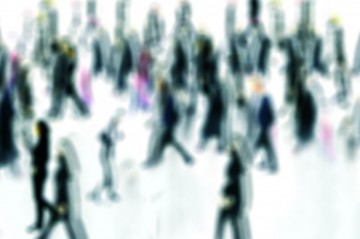Ursula Groser
ÜBERTRITT
August 31, 2008 – October 18, 2008
In her new work Ursula Groser sounds the spectrum of our existence as an individual and as part of society and hence crowd. The tension that she creates 12am - 6pm also serves as a playground and source of diametric contrary fears and wishes for closeness and independency.
In ‘Übertritt’ Groser assembles step by step the amalgation of individuals to a group and the resulting disintegration to an abstract texture-like pattern. Elias Canetti describes and analyses in ‘Crowds and Powder’ the for Groser eminent process as follows:
‘The crowd, suddenly there where there was nothing before, is a mysterious and universal phenomenon. A few were standing together, five or ten or twelve, not more. Nothing was announced, nothing expected. Suddenly everything is black, full of men. They are nearing from everywhere, as if all streets had only one direction. Many of them don’t know what happened, they have nothing to answer the questions. But they are in a hurry to be there where most of them are. There is a determination in their movement that differs in its expression from common curiosity. The movement of the ones communicates with the others but that is not everything: they have a goal. It is there before they have found the words for it: the goal is the most black – the place where most men are together.’
Groser draws society as a gravity point of human togetherness, as a black hole that focuses energy and in which the individual dissolves. It is this moment that she describes as ’Übertritt’ and dissolution into the crowd.
‘There is nothing man fears more than the touch of the unknown.’ E. Canetti
While in the video men walk in and over each other, in the narrowness of the Ehegraben this is not possible without a closer body contact. The physical closeness of the other visitor obliges every single one to develop a strategy of how this encounter can be met. Social or individually developed rituals are hence rationalizing irrational fears of such a physical contact. Canetti says: ’It is only in a crowd that man can become free of this fear of being touched. That is the only situation in which the fear changes into its opposite.’
In ‘Übertritt’ Groser assembles step by step the amalgation of individuals to a group and the resulting disintegration to an abstract texture-like pattern. Elias Canetti describes and analyses in ‘Crowds and Powder’ the for Groser eminent process as follows:
‘The crowd, suddenly there where there was nothing before, is a mysterious and universal phenomenon. A few were standing together, five or ten or twelve, not more. Nothing was announced, nothing expected. Suddenly everything is black, full of men. They are nearing from everywhere, as if all streets had only one direction. Many of them don’t know what happened, they have nothing to answer the questions. But they are in a hurry to be there where most of them are. There is a determination in their movement that differs in its expression from common curiosity. The movement of the ones communicates with the others but that is not everything: they have a goal. It is there before they have found the words for it: the goal is the most black – the place where most men are together.’
Groser draws society as a gravity point of human togetherness, as a black hole that focuses energy and in which the individual dissolves. It is this moment that she describes as ’Übertritt’ and dissolution into the crowd.
‘There is nothing man fears more than the touch of the unknown.’ E. Canetti
While in the video men walk in and over each other, in the narrowness of the Ehegraben this is not possible without a closer body contact. The physical closeness of the other visitor obliges every single one to develop a strategy of how this encounter can be met. Social or individually developed rituals are hence rationalizing irrational fears of such a physical contact. Canetti says: ’It is only in a crowd that man can become free of this fear of being touched. That is the only situation in which the fear changes into its opposite.’

